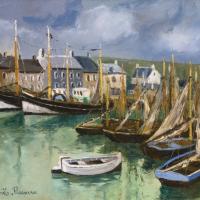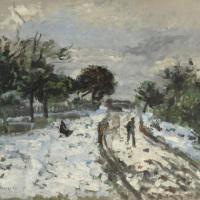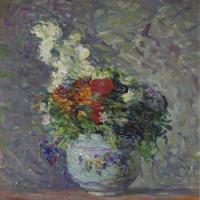Maurice De Vlaminck
Maurice De Vlaminck
Maurice De Vlaminck (1876-1968)
Maurice de Vlaminck , born in Paris on April 4 , 1876 and died in Rueil-la-Gadelière (Eure-et-Loir) on October 11 , 1958, is a French painter who has illustrated himself in the Fauvist and Cubist currents . Painter of figures, portraits, nudes, landscapes, animated landscapes, urban landscapes, interiors, still lifes, flowers and fruits, gouache painter, watercolourist, engraver, draftsman and illustrator, he is also a writer, publishing twenty-six books: novels , essays and collection of poems.
His pianist mother and violinist father, Edmond Devlaeminck, emigrated from their Flanders hometown for France. Her younger sister, Solange de Vlaminck , will once be a movie star , and, blind, will be married after the war by a fickle Elie-Joseph Bois , editor of the Petit Parisien by which the painter will gain notoriety, before to divorce and to fall into an indigence which her brother will refuse to release.
He spent his childhood in Vésinet but especially in Chatou from 1893 to 1905, where he made his first works. He made his first paintings around 1893 , but initially earned his living as a violinist and sometimes winning cycling races. He married in 1896 with Suzanne Berly, with whom he will have three daughters. Vlaminck is an autodidact, who also refuses to be trained by copying in museums so as not to lose or fade his inspiration.
It's the June 18 , 1900 on the occasion of the derailment of a train he met André Derain , who will remain his friend for life. They also rent a studio together in Chatou, in the current House Levanneur, which today houses the Cneai (National Center Art Image Edition). The latter leaves the joint workshop a year later, but he will keep an epistolary relationship followed (the letters of Derain were published but those of Vlaminck are lost). Derain found Vlaminck around 1904 . This period (1900-1905) remains a difficult period financially for the painter, in charge of family, and he is obliged to scrape old paintings to recover the paintings. Moreover, it is at this time that he publishes two novels with decadent aesthetics, even pornographic. That said, his true passion remains linked to primitive art and fauvism .
In 1905 , he moved to Rueil-Malmaison , while Derain won the afternoon, like many artists of that time. Vlaminck chose to stay in the Paris region, perhaps for taste, but also probably for lack of resources. He participated, that year, in his first Salon of independents . Vlaminck is one of the painters who are scandalous at the autumn show of 1905 , said "The cage with wild animals," with Henri Matisse , André Derain and Raoul Dufy . The art dealer Ambroise Vollard became interested in his work the following year, bought many paintings and devoted an exhibition in 1908 . Vlaminck also links with Daniel-Henry Kahnweiler , another famous art dealer. He also begins a ceramist activity . He made several international exhibitions during these years.
Vlaminck, having three daughters, was not sent to the front during the First World War . He is assigned to a factory in the Paris region. At the end of the conflict, he divorces and remarries with Berthe Combe, who will give him two daughters: Edwige and Godelieve. He moved from 1925 to Rueil-la-Gadelière until his death. His wife died there in 1974 at the age of 82.
1939, he presided at the banquet of the Vitalists who intend to defend, among others, Celine's anti-Semitic pamphlets against the law of morality introduced by the Senate to ban them, during which is burned a portrait of Adolf Hitler , " art critic who allowed himself, as ex-house painter, to assert that all the artists of the French school were degenerates “
In November 1941, Vlaminck participated in the trip to Germany with among others Paul Belmondo , Charles Despiau , Paul Landowski , Louis-Aimé Lejeune , Van Dongen , Andre Derain , André Dunoyer de Segonzac , organized by Propagandastaffel , under the orders of the German officers Schnurr and Ehlmsen. Vlaminck appears as "a rich thug and formerly red, stubborn as a peasant". Vlaminck regularly receives dinner at his home in La Tourtillière, the German officer Werner Lange of Propagandastaffel and deputy director of the Berlin Museum of Fine Arts, which he knew before the war and to whom he entrusts his daughter to discover Paris . According to Werner Lange, who was responsible for watching over and watching Parisian artists, Vlaminck eats better during the war than before! Werner suggests that Vlaminck practices the black meat market.
In June 1942, Vlaminck published an article entitled "Opinions Libres ... on painting" in Comœdia where he accuses Picasso"monk-headed figure of Inquisitor" to "the appearance of a monster" to have led 1900 to 1930 French painting "in a deadly impasse, in an indescribable confusion". The article published at the time of the Parisian retrospective of the sculptor Arno Breker provoked the indignant answers of Jean Bazaine in the NRF and confused of André Lhote. Vlaminck resumed his attacks in a second article on September 5, 1942 in Comœdia "On painting ... invention and gift", then in his book "Portraits before death" published in 1943 where he says all the evil he think of Degas , Picasso, Matisse ...
For Laurence Bertrand-Dorléac: "If Vlaminck's plan had been to end forever with the demiurge, he missed his shot, savoring in return for the unhealthy joys of denunciation - and guilt. He tried to settle his old accounts with the head of a modern family, of which he had been the child prodigy himself before repudiating her, there as elsewhere, everyone, from near or far, had belonged to the defiled body. On the way to sanitation, he confessed, Picasso was "the birth attendant" of Cubism, "perversity of the spirit, insufficiency, amoralism."
On liberation , the National Committee of Writers condemned Vlaminck to the ban on publication.
After the war, Vlaminck retired to the Tourillière. He died in 1958, and is buried in the cemetery of the town. His bust is erected in front of the town hall of Rueil-la-Gadelière . A hiking circuit in his name allows, during a journey of eight kilometers, to observe many landscapes that have inspired his works.
A great admirer of Vincent van Gogh , whom his friend André Derain introduced to him, he often draws inspiration from his paintings from his beginnings, using both a very pure color "output of the tube" and by effects of tourbillon. The Country Party at Bougival ( 1905 ) is a striking example. Neglecting a little compositional research, he is more interested in the spatial and affective qualities of color.
Vlaminck goes from impressionism to fauvism , more rebellious, more unbridled. He remains especially unique in the long years of his life as a painter. The strong personality of Maurice de Vlaminck is clearly expressed, by its ardor and robustness, in a bold paste painting, generous, and wide and safe keys.
From 1907 , Vlaminck perceives the limits of fauvism and discovers the work of Paul Cézanne. His graphics will be deeply influenced and his palette will become darker.
Vlaminck is one of the first collectors of African art. He began acquiring objects in the early 1900s. His pioneering role was recognized by Guillaume Apollinaire in 1912 . However, this does not influence his painting, unlike that of André Derain or Pablo Picasso.





